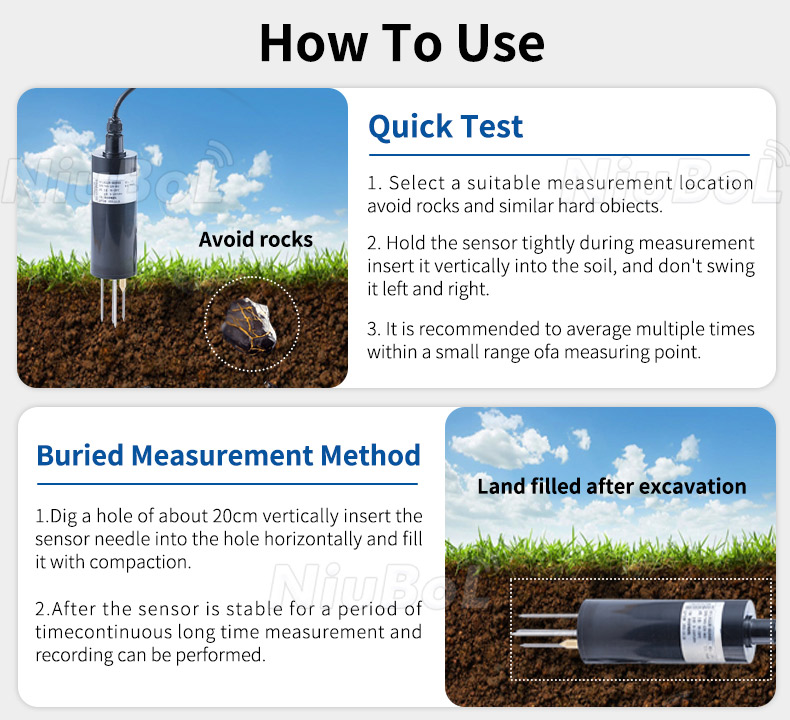

— Blogs —
—Products—
 Consumer hotline +8618073152920
Consumer hotline +8618073152920 WhatsApp:+8615367865107
Address:Room 102, District D, Houhu Industrial Park, Yuelu District, Changsha City, Hunan Province, China
Product knowledge
Time:2024-04-12 13:57:44 Popularity:632
A soil temperature and humidity sensor is a device used to measure soil temperature and humidity, and such sensors have a wide range of applications in agriculture, meteorology, and geological monitoring.
When the sensor is placed in the soil, it can sense the temperature and humidity changes of the soil and convert these physical quantities into electrical signals. The data acquisition module is responsible for converting these electrical signals into digital signals and sending the data to a monitoring system or recording device through a transmission interface.
Soil temperature and humidity sensors can help farmers or researchers to understand the state of the soil and provide data support for crop irrigation and planting decisions. In the field of meteorology, such sensors can be used to monitor ground temperature and humidity, providing data for weather forecasting and climate research. In geological monitoring, soil temperature and humidity sensors can be used to monitor the stability of the soil layer, providing reference for early warning of geological disasters.
1. Measuring range and accuracy: Make sure that the measuring range of the sensor can cover the range of soil temperature and humidity you need, and that its accuracy meets the needs of your application.
2. Stability and reliability: The stability and reliability of the sensor is the basis for long-term accurate measurement. Choosing a well-known brand or a proven product is usually more reliable.
3. Suitable soil types and environments: Different sensors are suitable for different types of soil, some are better suited to clay soils while others are better suited to sandy soils.
4. Installation and maintenance: Consider the difficulty of installing the sensor and the maintenance requirements. Some sensors may require specialized tools for installation, or periodic calibration and maintenance.

5. Transmission distance and mode: Determine the sensor's ability to transmit data. Wireless sensors may need to consider signal transmission distance and interference issues, while wired sensors need to consider the ease and cost of wiring.
6. Data output format and interface: Ensure that the data format output by the sensor is compatible with your data collection and processing system. Consider the type of interface provided by the sensor, such as analog output, digital output (RS232, RS485, lorawan, WiFi, etc.).
7. Cost and budget: The cost of the sensor is an important consideration. Choose a cost-effective product that meets your needs.
8. weather resistance and protection rating: the sensor should be weather resistant enough to withstand harsh weather conditions such as rain, snow, UV rays, etc. The protection rating is also an important consideration to ensure that the sensor is able to function properly under the expected environmental conditions.
9. Power requirements: Consider the power requirements of the sensor, such as whether 5V or DC12V is required, including wireless sensor battery life, power stability, and whether an external power supply is required.
10. Vendor support and compatibility: Choose a vendor that offers good technical support and update services to ensure that the sensors are compatible with your existing system and can be upgraded or replaced in the future.
Taking these factors into consideration, you can choose the soil temperature and moisture sensor that suits your needs, thus ensuring effective operation of your irrigation system and efficient management of resources.
NBL-S-THR-Soil-temperature-and-moisture-sensors-Instruction-Manual-V4.0.pdf
Prev:Principles and Methods of Soil Moisture Sensor Controlled Irrigation
Next:Optimizing irrigation strategies: integrating crop needs with environmental factors
Related recommendations
Sensors & Weather Stations Catalog
Agriculture Sensors and Weather Stations Catalog-NiuBoL.pdf
Weather Stations Catalog-NiuBoL.pdf
Related products
 Combined air temperature and relative humidity sensor
Combined air temperature and relative humidity sensor Soil Moisture Temperature sensor for irrigation
Soil Moisture Temperature sensor for irrigation Soil pH sensor RS485 soil Testing instrument soil ph meter for agriculture
Soil pH sensor RS485 soil Testing instrument soil ph meter for agriculture Wind Speed sensor Output Modbus/RS485/Analog/0-5V/4-20mA
Wind Speed sensor Output Modbus/RS485/Analog/0-5V/4-20mA Tipping bucket rain gauge for weather monitoring auto rainfall sensor RS485/Outdoor/stainless steel
Tipping bucket rain gauge for weather monitoring auto rainfall sensor RS485/Outdoor/stainless steel Pyranometer Solar Radiation Sensor 4-20mA/RS485
Pyranometer Solar Radiation Sensor 4-20mA/RS485
Screenshot, WhatsApp to identify the QR code
WhatsApp number:+8615367865107
(Click on WhatsApp to copy and add friends)